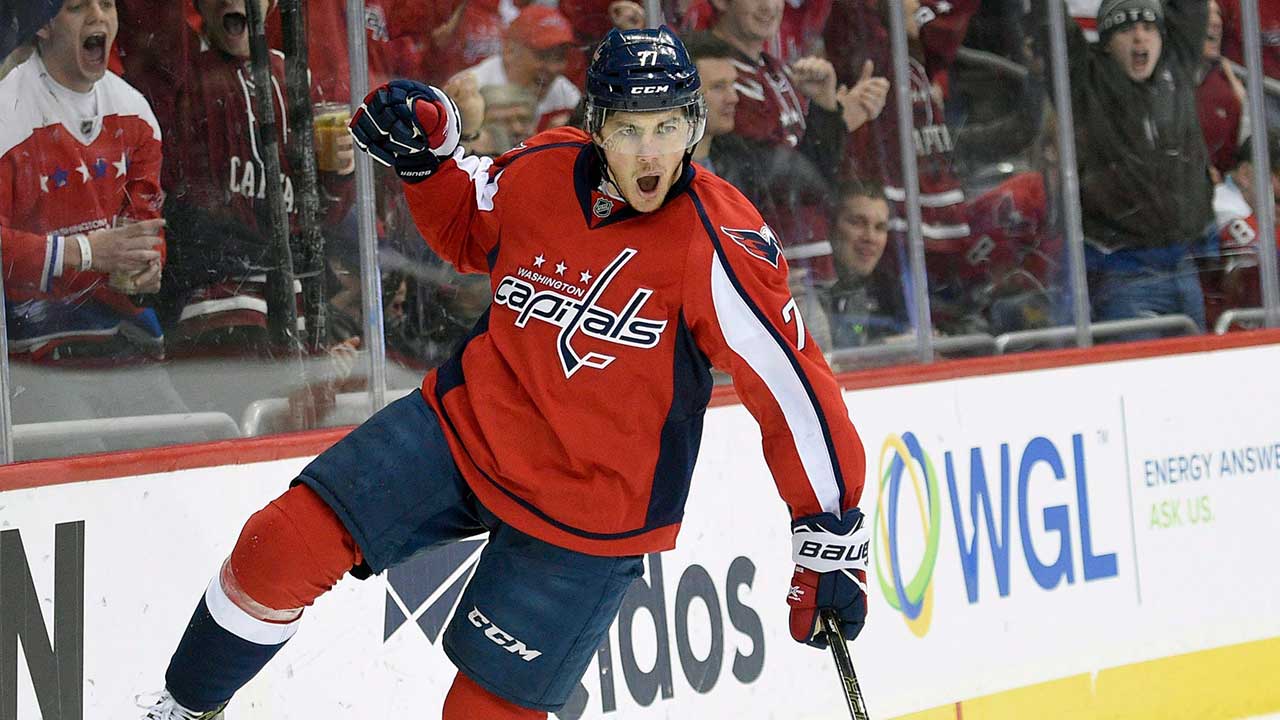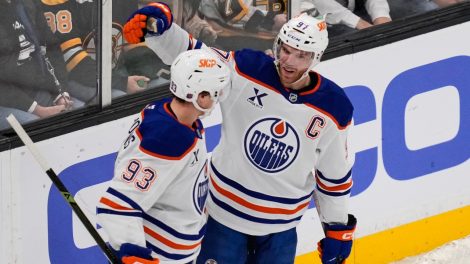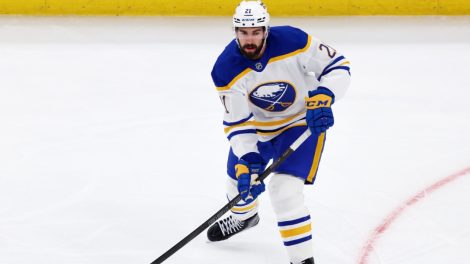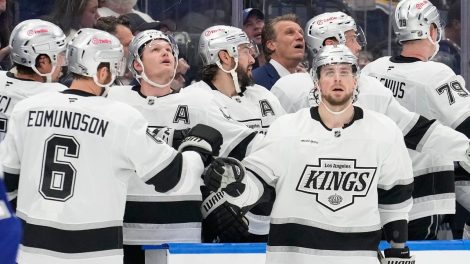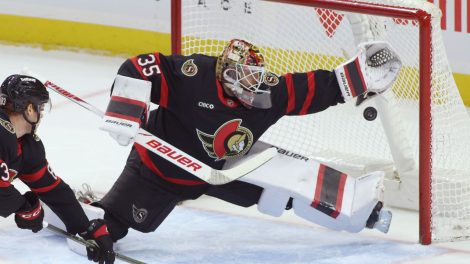Whether as analysts or as fans, one of the most important things we can do to further our understanding of the game is to use the past as a source of information to learn from.
Things eventually change over time – just look at the rates at which teams are now generating shots and goals compared to prior years, a byproduct of a faster, more skill-based game.
Yet as much as the NHL product continues to evolve, there’s one fundamental point that everything circles back to in this sport: skaters typically tend to convert a certain percentage of their shots into goals, and goaltenders conversely tend to stop a certain percentage of those shots.
If a player or team either exceeds expectations or performs poorly, chances are it’s at least partly because the puck luck arrow has swung too far to either extreme. Not that it’s much consolation when a season has gone down the drain because of bad luck, but the silver lining is that unless there’s an obvious change in skills (usually due to age), or you just so happen to be a Hurricanes goalie, this stuff has a funny way of eventually evening out over time.
[snippet id=3317857]
As such one of my favourite little annual projects to do at the end of the year is to identify the players who stick out on either end of the spectrum, earmarking them as potential regression candidates for the following season. As a frame of reference, the league average conversion rate for forwards tends to hover somewhere between 10 and 11 per cent in a given campaign.
Next week we’ll apply this very same exercise to this year’s pool of players and identify the next batch of outliers. But before we do that, let’s take a look back at last year’s list to see how things turned out for the forwards we flagged, and if there’s anything we can glean from it.
| Player | 2016-17 Shooting % | 2017-18 Shooting % |
|---|---|---|
| Corey Perry | 8.8 | 10.9 |
| Riley Sheahan | 1.8 | 10.1 |
| Patrice Bergeron | 7.0 | 13.4 |
| Jordan Eberle | 8.7 | 14.3 |
| Derick Brassard | 7.2 | 10.7 |
| Tyler Seguin | 8.6 | 12.3 |
| Jonathan Toews | 10.6 | 9.5 |
| Gustav Nyquist | 7.3 | 10.1 |
| Mike Cammalleri | 7.0 | 4.4 |
| Boone Jenner | 8.5 | 7.0 |
| Joe Pavelski | 12.4 | 9.6 |
| Chris Kunitz | 6.7 | 15.6 |
| Mats Zuccarello | 7.9 | 9.2 |
| Anze Kopitar | 8.0 | 17.9 |
| Patrick Kane | 11.6 | 9.6 |
| Brendan Gallagher | 5.3 | 11.5 |
| Johnny Gaudreau | 9.9 | 10.4 |
The most practical application of this thought exercise is to avoid letting one unrepeatable season cloud your judgement about a player’s worth and abilities. If you happen to be one of the 31 NHL GMs, it can even go so far as to save you from making a disastrous decision of either overcommitting financially to a player who won’t be able to replicate his success (more on this in a second), or selling off a player when their perceived value has temporarily dropped for however many cents on the dollar.
There may be no better real life example of this idea than Jordan Eberle, whose trade should be used as a cautionary tale. After a down season by his usual standards, he was traded away for a cheaper, but significantly less productive player. What made the decision to do so particularly puzzling was that the year looked like your typical blip on the radar for a player who had otherwise proven to be one of the most consistent goal scorers in the league.
In the time between the end of the season and the eventual trade, I posed the question: “What are you willing to believe more: the 14.1 per cent shooting on over 1,000 shots spanning six seasons prior to this year, or the 8.2 per cent shooting on less than 200 shots this season?”
The former has been validated in a landslide by Eberle’s debut season with the Islanders, as he’s not only returned to form, but actually produced nearly identical results to his career norms prior to 2016-17:
| Season | Goals/82 Games | Shooting % |
|---|---|---|
| 2010-2016 | 28 | 14.1 |
| 2016-2017 | 17.3 | 8.7 |
| 2017-2018 | 27 | 14.3 |
Let’s hammer through as many of these most notable individual cases as possible:
• Riley Sheahan’s 1.8 per cent clip was obviously comically unsustainable. If you expand the stretch to include Detroit’s post-season games in 2015-16, and his first eight games this season, Sheahan shockingly scored in just one of his final 93 games as a member of the Red Wings. In Pittsburgh, he’s been perfectly serviceable as a pivot on the fourth line who can move up as a stopgap if need be. What happened there towards the end in Detroit, and more specifically what he did to anger the hockey gods, remains one of life’s big mysteries.
• Patrice Bergeron is interesting here because his shooting percentage has wildly swung in alternating seasons. Since 2011, here are his totals by year: 11.5, 8.0, 12.3, 9.8, 11.3, 7.0, 13.4. The good news is that even in the down years, he’s still productive because of how often the Bruins have the puck when he’s on the ice, and the high volume of shots he generates himself. With the year he’d been having prior to getting hurt, it looks like he could’ve potentially approached 35 or 40 goals for the first time in his career had he stayed healthy.
• Mike Cammalleri is one of the only players on this list who hasn’t improved or at least hung around the ballpark of league average. He has just two goals in 47 games since joining the Oilers, so that’ll do it. Considering he’s turning 36 this summer, combined with all of the injuries he’s dealt with over the years, it’s fair to wonder whether he has anything left in the tank at this point.
• Few things have gone right in Dallas of late, with the Stars collapsing down the stretch. Unless something dramatically changes, they’ll likely miss out on the post-season despite looking like a sure thing just a couple of weeks ago. But it hasn’t been all bad. One positive to draw from is Tyler Seguin’s return to being one of the league’s most prolific goal scorers, as he’s about to break the 40-goal mark for the first time. To put his year in perspective, only Alex Ovechkin has been responsible for a greater share of his team’s total goals:
| Player | % of Team’s Goals Scored |
|---|---|
| Alex Ovechkin | 20.27 |
| Tyler Seguin | 18.22 |
| Connor McDavid | 18.18 |
| Eric Staal | 17.39 |
| Patrik Laine | 17.13 |
| Evgeni Malkin | 16.73 |
| Anders Lee | 16.05 |
| Nathan MacKinnon | 15.97 |
| William Karlsson | 15.60 |
| Brendan Gallagher | 15.46 |
| Anze Kopitar | 15.32 |
| Vlad Tarasenko | 14.83 |
| Sean Monahan | 14.78 |
| Brock Boeser | 14.57 |
| Rickard Rakell | 14.49 |
| Taylor Hall | 14.29 |
| Nikita Kucherov | 14.23 |
• Two other names that appear on both lists are Anze Kopitar and Brendan Gallagher, who have had excellent bounceback campaigns. The latter’s year carries less overall significance considering his team’s struggles, but 30 goals in today’s landscape is still impressive. It’s crazy to think how bad things could’ve potentially gotten for the Canadiens if it weren’t for Gallagher singlehandedly willing the puck into the back of the net as often as he has. Even with his excellence, the team is still 28th in offence.
Kopitar, on the other hand, looks like he might just drag his team into the playoffs. If it weren’t a year in which players like Nathan MacKinnon and Connor McDavid were doing things we hadn’t seen in a long time, he’d deservedly be getting much more Hart Trophy buzz than he has. After a season from hell in 2016-17, Kopitar’s going to set personal highs in goals, assists, and points, all while eating up north of 22 minutes a night for a Kings team that’s needed every single bit of it.
[snippet id=3816507]
• Boone Jenner’s year as a whole doesn’t look great, but it’s worth noting that he’s come alive since the Blue Jackets went out and acquired Thomas Vanek at the deadline. His PDO of 118 has surely played a big role in it, but the combination of Jenner, Vanek, and Alex Wennberg have outscored opponents 16-2 in the 120 minutes they’ve spent together at five-on-five, controlling a stunning 57.5 per cent of the total shot attempts, and 58.1 per cent of the shots on goal. Jenner himself has scored six of his 12 goals on the year in those 14 games, after having scored just six times on 140 shots in his first 56 games this season. That kind of secondary scoring has come at just the right time and made the Blue Jackets a serious threat as we approach the post-season.
Now let’s spin it around and look at the other end of things, with a glance at the players that looked to be running inordinately hot last season:
| Player | 2016-17 Shooting % | 2017-18 Shooting % |
|---|---|---|
| Rickard Rakell | 18.6 | 14.8 |
| TJ Oshie | 23.1 | 13.6 |
| Mark Scheifele | 20.0 | 19.5 |
| Michael Grabner | 16.7 | 17.3 |
| Mikael Granlund | 14.7 | 10.3 |
| Anders Lee | 17.8 | 20.1 |
| Nazem Kadri | 13.6 | 15.2 |
| Marian Hossa | 15.6 | n/a |
| Eric Staal | 13.3 | 18.3 |
| Patrick Maroon | 15.2 | 11.9 |
| Sidney Crosby | 17.3 | 11.7 |
| Cam Atkinson | 14.6 | 9.5 |
| Marcus Johansson | 18.6 | 11.9 |
| Artem Anisimov | 21.0 | 16.5 |
| Evander Kane | 10.8 | 9.8 |
| Paul Byron | 22.9 | 17.9 |
| Patrik Berglund | 15.0 | 12.6 |
• Rickard Rakell expectedly came down a bit in shooting percentage this season, but has managed to sustain his raw scoring pace because he essentially got to play more, and took advantage of it by shooting the puck more, too. Considering all the injuries they’ve had and the individual upswing he’s on in his career, it makes sense that he’ll only continue to play a bigger role as an offence-driver for the Ducks.
• Everything about Marian Hossa throughout his playing career was perfect. As it turns out, that also included the decision to get out at just the right time.
• Michael Grabner is a fun player who can change the game with his speed. He was a great find by the Rangers, who squeezed 52 goals and a second-round pick from him for just a measly $3.3 million. It’ll be fascinating to see what he goes for on the open market this summer. Of the 54 goals he’s scored over the past two seasons, 11 of them have come on an empty net (seven of which have come just this season alone):
| Player | Empty Net Goals 2016-2018 |
|---|---|
| Michael Grabner | 11 |
| Eric Staal | 9 |
| Alex Steen | 7 |
| Vincent Trocheck | 7 |
| Patrick Marleau | 7 |
| John Tavares | 7 |
| Alex Radulov | 6 |
| Jack Eichel | 6 |
| Artemi Panarin | 6 |
| Jack Eichel | 6 |
• Normally you’d look at a player shooting around 20 per cent and recoil at the thought of what that could mean for the future. It’ll most likely come down a couple notches next season anyways, but in the case of Anders Lee I’m willing to buy that he’ll be able to live comfortably in the mid-teens based on where he does most of his damage. He’s cemented himself as one of the league’s most lethal net front players over the past two seasons, peppering the puck on net from right in front, and scoring a healthy chunk of his goals on the power play. If he can score 30-plus goals yet again next season, he’ll cash in handsomely on his next contract, high shooting percentage or not.
• I wonder how the Blues feel about the five-year, $19.25 million extension they gave Patrik Berglund now that he’s not shooting 15 per cent and scoring 23 goals. Same goes for the Blue Jackets, who have an unfortunate history of rewarding their players for shooting percentage spikes. Cam Atkinson is a perfectly fine top-six winger who should be good for somewhere in the mid-20s in goals, but that doesn’t excuse paying up for him when he was in the midst of a career year.
Iit’s fascinating how much of this stuff just comes down to timing. You can’t help but wonder what someone like Patrick Maroon would’ve got for himself (and how much money he’s since lost) had he been in a contract year last summer instead of his this coming one.
• From last year’s piece: “Even though Oshie will still retain some value as a top-six winger when he reverts back to what he was prior to this season (hovering around 20 goals and 50 points), it’ll wind up falling well short of his price tag and the attached expectations, making him just the latest in a long line of big money free agents that resulted in near-instant buyer’s remorse.”
Oshie is basically the Bizarro Jordan Eberle here. Look at how his time in the NHL has unfolded. One perfectly timed career season in a contract year, and he’s now $46 million richer for it. It’s going to be difficult to talk about him and his production objectively moving forward because of the extenuating circumstances, but for whatever it’s worth he’s once again back to being the exact player he was prior to last season:
| Season | Goals/82 Games | Shooting % |
|---|---|---|
| 2008-2016 | 21.3 | 12.2 |
| 2016-2017 | 39.8 | 23.1 |
| 2017-2018 | 19.6 | 13.6 |
The issue for the Capitals is that they bought a luxury car when they had other more vital day-to-day needs to tend to, and now find themselves in quite the financial bind. Having already lost all sorts of talent this past summer, they face the very realistic possibility of sitting back and watching John Carlson cash in on July 1.
That’s ultimately the issue with the Oshie signing. It’s nothing against the player because he’s still undeniably a valuable middle-six contributor. The issue instead is all about the opportunity cost, and the repercussions they’ll face for committing such a large piece of the pie to a player they didn’t necessarily need.
[relatedlinks]
